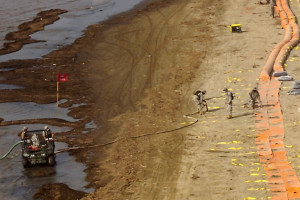 On Wednesday, September 2nd, 2015 the United States Coast guard reported a crash between two towboats along the Mississippi River. A total of six barges were damaged in the collision including the Inland Marine Service barge containing 1 million gallons of clarified slurry oil. One of the tanks containing the oil was damaged severely enough that about 250,000 gallons of the oil spilled into the Mississippi River. Immediately after the collision was reported, the Coast Guard closed travel along the river at mile marker 937, north of Columbus, Kentucky and alerted a pollution response team to contain the oil spill.
On Wednesday, September 2nd, 2015 the United States Coast guard reported a crash between two towboats along the Mississippi River. A total of six barges were damaged in the collision including the Inland Marine Service barge containing 1 million gallons of clarified slurry oil. One of the tanks containing the oil was damaged severely enough that about 250,000 gallons of the oil spilled into the Mississippi River. Immediately after the collision was reported, the Coast Guard closed travel along the river at mile marker 937, north of Columbus, Kentucky and alerted a pollution response team to contain the oil spill.
As of Thursday, the Coast Guard reports that it is working with the owner of the barge also involved in the crash, the Inland Marine Services, and the oil spill response organization to discover the exact amount of oil spilled. While there are no reported injuries, the Coast Guard is investigating to determine the cause of the collision and if there was fault by either vessels in the accident. A total of 5 barges were damaged in the crash, though nothing affected the river accept the oil from one tank carrying the 250,000 gallons of clarified slurry oil. Both towboat operators involved in the accident were questioned and submitted to a drug test – results have not yet been released.
Slurry oil is a heavy, aromatic residual product collected from a refinery’s fluid catalytic cracking unit. It’s typically used to mix into heavy fuel oil to cut the viscosity of the fuel oil. Since slurry oil is heavier than water, it tends to sink below the surface and settle on the riverbed below.
On the following Friday after the incident, the Coast Guard called in an aerial observation of the river to determine the location of the remaining oil still in the river. This “flyover” also helped to establish the amount of work ahead of the pollution response team as it worked to clean up the oil. While there has not been confirmation that the slurry oil was completely eradicated from the river, there have also not been any reports of fish dying or washing up on the shore.

Soldiers of the Louisiana National Guard’s 1023rd Vertical Engineer Company, 528th Engineer Battalion continue constructing the interlocking water diversion system, May 14, near Venice, La., at the southwest pass of the Mississippi River Delta. The dam will act as a second line of defense to the boom line, in order to protect the natural marshlands.
Traffic along the part of the Mississippi river affected by the oil spill has since reopened though clean-up efforts and the investigation are still underway.
Few can forget the effects of the catastrophic BP oil spill at the same time the previous year. In the case of BP, “gross negligence” was the cause of what is now described as the largest United States oil spill in history. The tragedy took the lives of 11 people and oil coated the waters and washed up on the shores of 5 states. After a hearing before District Judge Carl Barbier, with the absence of a jury, BP was handed out a $4 billion penalty for the negligence of its employees.
The U.S. Coast Guard will be conducting an extensive investigation to determine the cause of the incident. It may be determined that one of the vessels was “moored” or stationary when struck by the other vessel (called the “offending” towboat). Where a vessel collides with a stationary object, this is called an “allision”. Meanwhile, if both vessels were underway (not stationary), this would be called a “collision”. In either case, the U.S. Coast Guard will evaluate whether either or both vessels violated the Inland Rules of Navigation intended to prevent collisions. In most allision and collision cases, the following rules of the road are usually implicated:
• Rule 2 – failure to use good seamanship (33 U.S.C. §2002)
• Rule 5 – failure to post/maintain a proper lookout (33 U.S.C. §2005)
• Rule 6 – failure to proceed at a safe speed (33 U.S.C. §2006)
• Rule 7 – failure to use all means available to avoid the risk of collision (33 U.S.C. §2007)
• Rule 8 – failure to take positive action to avoid collision, such as altering course and speed (33 U.S.C. §2008)
• Rule 18 – violation of Rule 1 – failure to comply with the above Rules of the Road (33 U.S.C. §2001)
